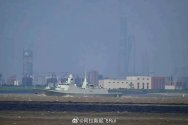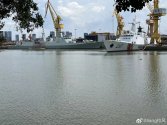(1)one side has qualified AEW - so it's outright wrong. AEW is not a guaranteed detection of everything within the bubble - it has to actually be in the air, close enough (targets are physically small in our case, so is their signature), not jammed*.Also using the Ukrainian war to demonstrate the superiority of low altitude subsonic missiles isn't very convincing because both sides, especially Ukraine, lacked qualified AWACS. This gave low altitude missiles an even greater advantage that will not exist as soon as an AWACS platform like the E-2 is available.
Note that I don't deny that the YJ-83 may still be a competitive missile, but using the experience in the Ukrainian war as a basis for this could be very misleading.
*jamming is no magic answer, but it will degrade and spatially limit radar's ability to detect and direct engagement against difficult borderline targets.
(2)if you're relying on a salvo of a single frigate to strike a target with its own E-2D in the range - you're doing something awfully wrong, you're probably already detected, and what you're doing is most probably meaningless regardless of whether it's YJ-83 or YJ-12 (which isn't invulnerable either - and in fact much less sneaky). Though if this somehow happened - may as well jam it; frigate can ham C/L, and shipborne jammers aren't joke. AESA AEW will detect you anyway, no need to hide.
(3)if you're talking about YJ-83 in aviation context - then an attack against a high-value target is indeed the way to go, but then no need to shy away from supporting it with both stand-in EW(China already paid a big premium for those J-15D/J-16D - jamming L-band is their job. Use them). Small, low-signature, very low-flying missiles benefit from ESM a lot.
Or you can(should) push the E-2 away from engagement zone with missiles - as mentioned earlier, even AEW range against small, terrain-hugging missiles isn't unlimited.
Last edited:



